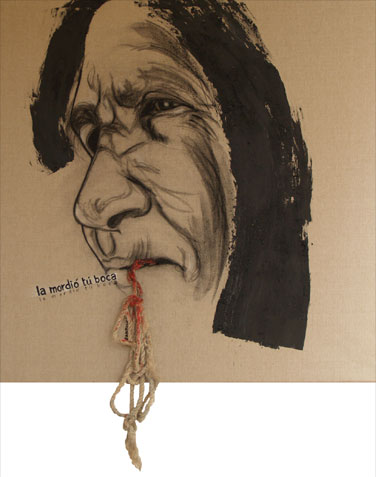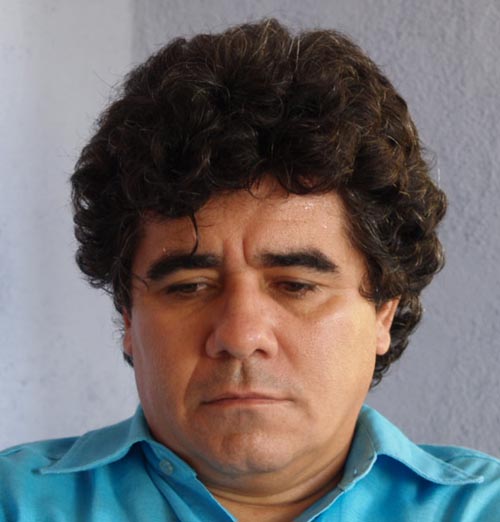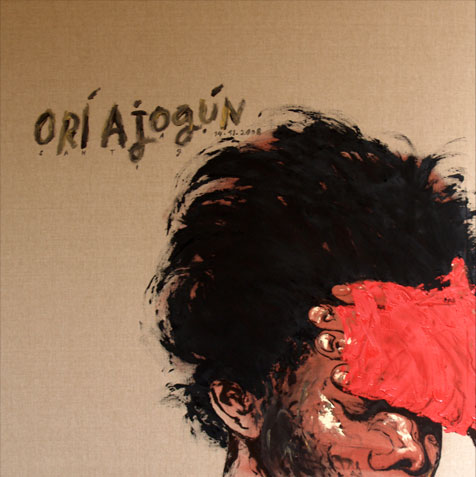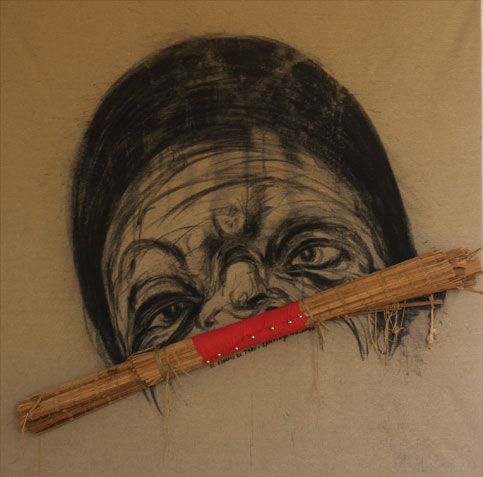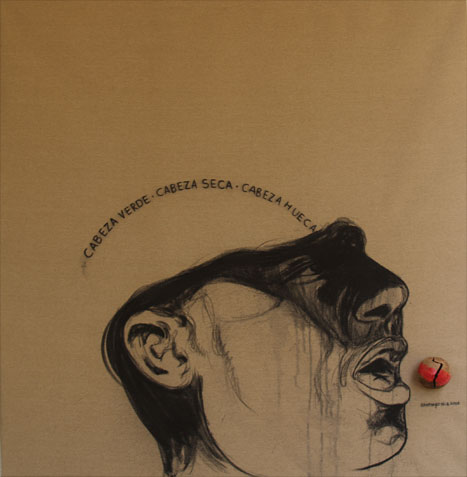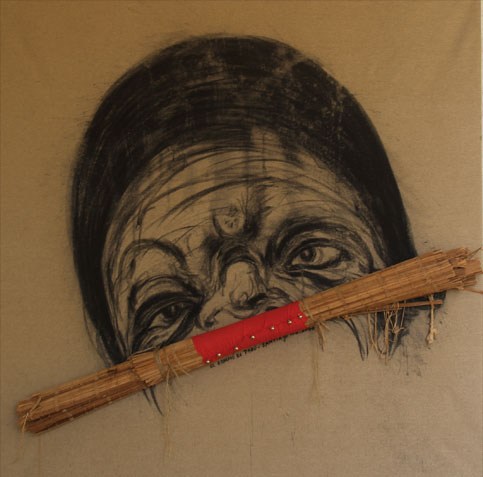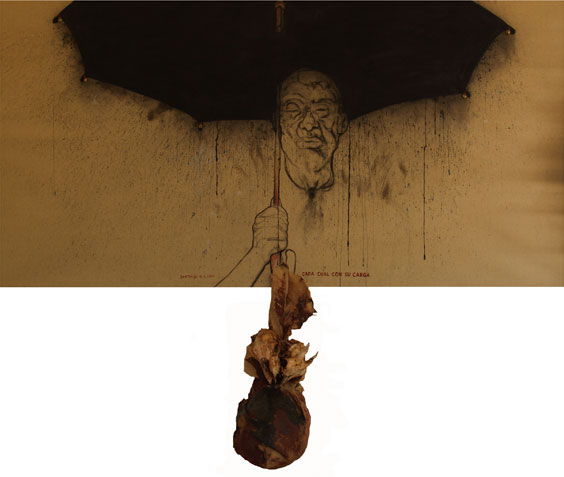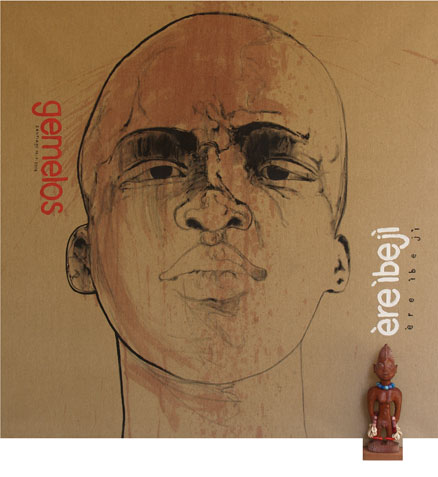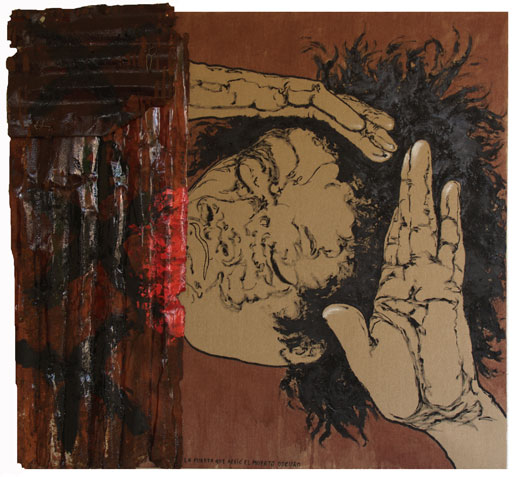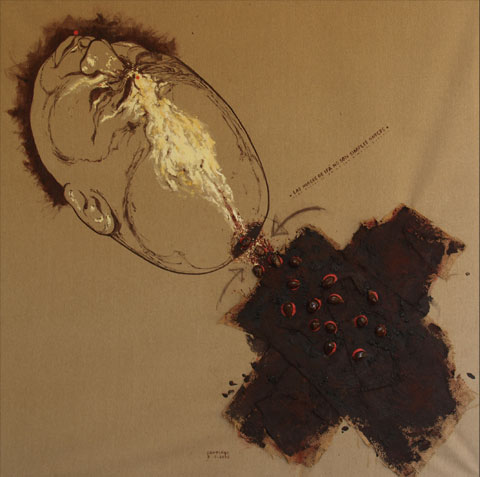Orí
Agbón Ilé House of wisdom
The solo show Orí. El Orisha is a new pretext to return to the work of Santiago Rodríguez Olazábal, one of the esthetic proposals that best integrates the essences of the religious rituals, ceremonies and particularly knowledge of the religious practices of African origin which, once transmuted and established in Cuba, operate with the context in its intersections, on the basis of contingency, pragmatism and operativeness.
Perhaps one of the most outstanding essences in the work of this artist is the far-reaching compendium of warnings mainly aimed at the moral destiny of the believer.
Olazábal follows that same essential meaning and purpose in and through his poetics, and at the same time recomposes a group identity that emerged as stated at other times on the basis of the experience, tradition and memories of diverse origins or of micro locations in a large region. It would have to be admitted that it emerged particularly from a hybridization blurred by the
tractions, negation, intolerance and prejudices first originated and evident since the system of colonial relations, and then by the incapability or impossibility of integration of post-colonial processes, particularly by historical reasons and racial distortions, even in those processes in which by law, as part of the official State policy, the new socio-cultural perspectives have attempted to reconstruct and vindicate the dimension of the different cultural universes and identities without utilizing the false and excluding strategy of the Messianic civilizing model in which popular religious expressions, particularly those coming from the black continent, were declared bastard.
Naturally, the urgency in Olazábal’s work is a modest one in spite of the incorporation of the entire philosophical background and trends of thought of the ritual practices into the corpus of his work for the purpose of legitimizing and extending the warnings of ethical nature and penetrating the behavior and daily moral conduct of human beings.
Santiago transcends the memory; in other words, he does not resign himself solely to vindicate and rescue the nostalgic testimony of syncretic religions from the world of reminiscence. He dignifies it through art, particularly with his sincere understanding of the vitality and projection of an order that does not require a religious one to prove its value and pertinence, nor moments of crisis to survive and evidence its influence.
Olazábal’s ingeniousness, the energy that overflows each one of his works, the provoking nature, the suggestive aura of the images and even the dramatic, intense meaning that emerges from his compositions transcends the cognitive relationship with the observer who simply observes but cannot avoid an inexplicable supra-sensorial interaction, even if he does not succeed in surmounting the apparently hermetic, symbolical universe that deprives him of the immediate anecdote.
As in the core of the Ifá Òrîsà cult, the texts, the phrases, the words in his work are not only vehicles; they are strong meanings of expressive, symbolical and semantic autonomy. In these works, the word replaces the absence of visual representativeness, but that importance of the verb invigorates in the end the link with the practitioner. This is what happens in Olazábal’s representation.
In the work I Tied Your Tongue, a large head, all painted in white, carries in its mouth a mixture of irons, knife, sticks real objects glued on the canvasincarnating the representation of Ogun, Orìsà of the woods, whose energy and braveness makes him a winner. The suggested reading, in its ambivalence, is subtle and intelligent: the tongue is bearer of the asé, since through the word we may achieve or destroy much and even everything. Ogún is highlighting the meaning of the word, although he is also restraining imprudence, arrogance, the expression adopted in order to cause damage.
The works selected for this exhibition excel the asepsis of former drawings as a result of a marked conceptual rigor, of the virtuous rationality of the craft, which weighs up the idea, and the expressionism that shows the inner force of both work and artist. The closed eyes of almost all the figures reveal the power of introspection, the need to look inside and recognize our inner universe.
The image is structured in a monumentality that may be sensed by the severity of the drawing, of the traces, the gestures, the stains, as if it were the snapshot of the convulse dynamics inherent to the ritual, to the sound of words and prayers that are part of that sacred, intimate act, but at the same time conceived to be assimilated from the apprehensive spirituality of human beings, in order to understand that the Òrìsà man or woman relationship is a dialogic one, but it is also a unique connection and a transaction in which much more is given and received than material welfare, and it is not only a cold negotiation, as unfortunately assumed by many who are trapped by the immediacy of the value of any benefit.
Olazábal validates the selection of specific odu, stories and ceremonies or jobs. Thus, the work Green Head Dry Head Hollow Head does not presume of a description, but rather of the conceptual and iconic synthesis to grasp the substance of the message. Ifá says that the tongue wants to speak faster than the head thinks, that is why The Nuts of Ifá Are Not Plain Nuts. Orúnmilà (The Witness of Creation) wanted to crack some nuts and called all the Orìsà, because no one achieved it, only Orí cracked them with his head. Since then, Orí is the first and is also supreme, vital and definitive; he is our thought, our reason, our conscience: your head guides you, but your head also destroys you. Of course, in the end Each One with His Load is an ironical, almost sarcastic work that moves us to accept our responsibility.
The universe of symbols inherent to the religious practice is oversized in Olazábal’s personal iconography, since he has created a new imagery that undoubtedly adds morphological complexity to the representations accompanying the cult.
Orí Méèrìn Layé symbolizes the four cardinal points that hold the world (the head of the cardinal points), the evocation of creation, but also of Orun (the great beyond, above) and Aiyé (the earth, below). And in that conception, Osun’s virtue (the last one to descend to the earth) to achieve the conciliation among all the deities; hence the use of mirrors and the golden pigment.
Olazábal is ever more consequent with the purpose of the inputs, materials and components in his work, which become essential meanings, as well as the incorporation of materials, the object of special load and visual energy. As a true alchemist, he produces his own pigments and uses alloys, powders and herb juices, which act as conceptual complement in his works and reinforce the meaning of the whole and its parts, without making concessions.
The versatility of this demiurge has enabled him to create an installation for a particular space in the gallery. Strictly speaking, he has assumed it as an experimental work in which, once more, he accepts the challenges of the specialty, he appropriates the emancipating nature of the installation, this time overflowed by the articulation favored by the multiple disciplines, the incorporation of sound through the music of Brazilian Egberto Gismonti, the concept for the stage lighting and the text display. The Sixteen Eyes of Osányin’s Head, represented by sixteen mirrors which are like psychic eyes, leads us to identify ourselves in that inverse and identical image, and to attempt to rediscover ourselves in the understanding, knowledge and wisdom (Agbón) of daily life.
Hilda María Rodríguez Enríquez
Artworks
I know something...
Santiago Rodríguez Olazábal 2013He broke the taboo
Santiago Rodríguez Olazábal 2008Green head. Dry head. Empty head.
Santiago Rodríguez Olazábal 2008He broke the taboo
Santiago Rodríguez Olazábal 2008Each with their burden
Santiago Rodríguez Olazábal 2008Eja tutu meta Ori
Santiago Rodríguez Olazábal 2008Twins
Santiago Rodríguez Olazábal 2008The door the dark dead opened
Santiago Rodríguez Olazábal 2008Your mouth bit it
Santiago Rodríguez Olazábal 2008Ifa's nuts
Santiago Rodríguez Olazábal 2008I tied your tongue
Santiago Rodríguez Olazábal 2008Artists
